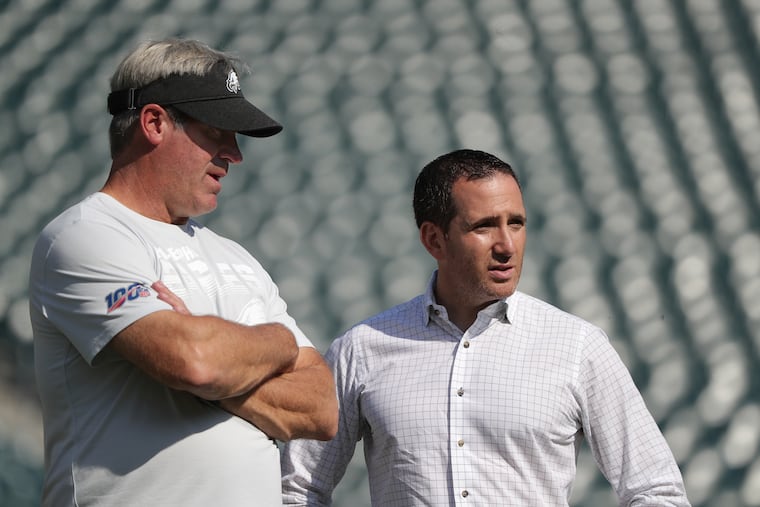The Eagles’ team-building strategy under Howie Roseman is running into a hard reality | Mike Sielski
The veterans the Eagles relied on to win a Super Bowl are aging and getting hurt, and Roseman hasn’t drafted well enough to replace them.

Doug Pederson was asked early Monday afternoon, as he customarily is at his day-after-the-game news conferences, about the status of the Eagles’ injured players, particularly those who would be starting or seeing ample playing time if they weren’t hobbled. So Pederson ran down the list. Jalen Mills and Ronald Darby might get some practice time this week. DeSean Jackson was day-to-day. And Pederson was still waiting for more information on Jason Peters and Nigel Bradham.
When it comes to the Eagles’ ragged 3-3 start this season and the 38-20 thumping that the Minnesota Vikings delivered to them Sunday, though, the list itself wasn’t necessarily the interesting or significant part of the injury situation that Pederson detailed. Here was the interesting and significant part: Every one of those five players had one or more fill-ins Sunday who got substantial action in his stead, and each of those replacements was a recent Eagles draft pick — often a relatively high one.
Mills and Darby were out, and Sidney Jones (second round) and Rasul Douglas (third round) played in their places. Each of them, Jones and Douglas, was on the field for more than 70% of the Eagles’ defensive snaps. Jackson was out, so Nelson Agholor (first round) and Mack Hollins (fourth round) had to “step up,” as football coaches like to say in the parlance of our times. Peters left the game, then came back, then left again, all because of a knee problem, which meant Andre Dillard, the Eagles’ first-round pick this year, played 47 snaps; Peters played just 18. Linebacker Nate Gerry (fifth round) was out there Sunday for more than twice as many snaps (62) as Bradham (29) was.
In the aftermath of such an embarrassing Eagles loss, it’s natural to go full Al Pacino-in-Any Given Sunday, dwelling on and hoo-hahing about the six inches in front of everyone’s face. And there was a lot happening Sunday in that half-foot that, for the Eagles, wasn’t good. Pederson never should have green-lighted that fake field-goal attempt late in the first half; the risk-reward proportion, given the situation, didn’t justify it. He called one too many wide-receiver screens to Alshon Jeffery, and the Vikings were ready for that play on an important third down, swarming Jeffery for a loss and forcing the Eagles to settle for an actual field goal. Malcolm Jenkins made a mental error in coverage that contributed to one of Stefon Diggs’ three touchdowns.
That’s the micro of an awful loss, but the macro might be more concerning. It would be one thing if, because of all those injured and unavailable players, the Eagles had to acquire and suit up a succession of practice-squad guys or free agents. It is another thing entirely that so many homegrown players already on the roster appear so unprepared for prime time. That issue speaks to a larger issue, to Howie Roseman and the front office’s relative inability to supply talent and depth through the draft.
In fairness, over the period since he regained personnel control after Chip Kelly’s departure, Roseman got the Eagles’ biggest, boldest draft pick right. He and his staff banked that Carson Wentz was worth two trades and the No. 2 overall pick in 2016, and Wentz has been. And Roseman made an astute calculation that, because Wentz could start immediately, the Eagles could take advantage of his cost-effective rookie contract by signing or trading for veterans on short-term deals.
That approach led to the franchise’s first Super Bowl victory, but it always came with a risk: that the older players the Eagles acquired or retained would be more susceptible to, and in turn sustain more, injuries. There would be a time that the team would have to assimilate younger players into the lineup, but at the moment, those younger players either aren’t yet equipped to fill such roles or — and here’s the scary part — may never be. Jones is in his second season. Douglas is in his third. They’re no longer neophytes, and their shortcomings, their lack of development, are a primary reason that the Eagles have to consider trading for a better, veteran cornerback to stabilize their secondary. Hollins has one catch in his last three games, and he’s still playing ahead of J.J. Arcega-Whiteside, who was drafted in the second round this year.
Whatever those facts say about Hollins, they say something worse about Arcega-Whiteside and the Eagles’ predraft evaluation of him, and this is hardly an isolated case. The four drafts that Roseman has overseen since his exile have produced too few impactful players. There’s Wentz. There are Dallas Goedert, Miles Sanders, and Avonte Maddox, maybe. There is Derek Barnett, solid but not a force. There are players who have been inconsistent or underwhelming and remain unknowns: Isaac Seumalo, Halpoulivaati Vaitai, Jones, Douglas, Mills. There are obvious misses: Donnell Pumphrey, Shelton Gibson, Clayton Thorson.
That record is spotty at best, and the Eagles sure seem to be suffering for it now. Near the end of his news conference Monday, Pederson insisted that they were “close. When I say we’re close, we’re close in a lot of areas. We are playing some young guys in some spots. They’re getting better every week.” For the sake of the Eagles’ season, they have to get better faster, if they can. For the sake of the Eagles’ future, Roseman has to improve his batting average, if he can.